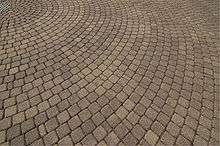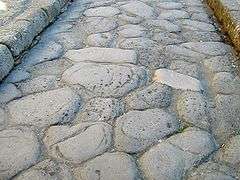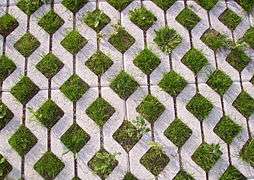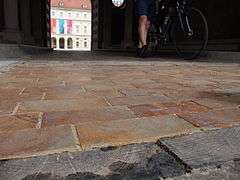Pavement (architecture)
Pavement in construction is an outdoor floor or superficial surface covering. Paving materials include asphalt, concrete, stone such as flagstone, cobblestone, and setts, artificial stone, bricks, tiles, and sometimes wood. In landscape architecture pavements are part of the hardscape and are used on sidewalks, road surfaces, patios, courtyards, etc.
Pavement comes from Latin pavimentum meaning a floor beaten or rammed down, through Old French pavement.[1] The meaning of a beaten down floor was obsolete before the word became English.[2]
Pavement laid in patterns such as mosaics were commonly used by the Romans.
Paver


A paver is a paving stone, tile,[3] brick[4] or brick-like piece of concrete commonly used as exterior flooring. In a factory, concrete pavers are made by pouring a mixture of concrete and some type of coloring agent into a mold of some shape and allowing to set. They are applied by pouring a standard concrete foundation, spreading sand on top, and then laying the pavers in the desired pattern. No actual adhesive or retaining method is used other than the weight of the paver itself except edging. Pavers can be used to make roads, driveways, patios, walkways and other outdoor platforms.
Interlocking concrete pavers

An interlocking concrete paver is a type of paver. This special type of paver, also known as a segmental paver, has emerged over the last couple of decades as a very popular alternative to brick, clay or concrete.[5]
Segmental pavers have been used for thousands of years. The Romans built roads with them that are still there. But it was not until the mid-1940s that pavers began to be produced out of concrete. It started in the Netherlands[5] where all the roads are made to be flexible because the country is below sea level and the ground shifts, moves and sinks. Poured concrete is not an option because it will crack. Individual units not set in concrete, and placed in sand perform far better than concrete.[5] Before the paver was made from concrete, either real stone or a clay product was used.
The first concrete pavers were shaped just like a brick, 4” by 8” (10 cm x 20 cm) and they were called Holland Stones and still are today. These units turned out to be economical to produce and were exceedingly strong.
Stone pavers
A stone paver is another type of paver. This type of paver is used widely in building and landscaping as it is highly prized for beauty, strength and durability. Stone pavers are made of many materials including limestone, bluestone, basalt (such as that from The Palisades used in New York City), sandstone and granite.[6]
Travertine is a durable, low-porous stone that stays cool in direct sunlight, making it a popular choice for pool-sides, patios, walkways and outdoor entertainment areas. Travertine is salt tolerant and has a low sunlight reflection. Granite pavers have high integral strength and density making it easy to maintain and hard-wearing in outdoor use. Limestone pavers are cut from natural limestone blocks, a sedimentary rock found in mountainous areas and ocean sea beds. Limestone tends to have unique natural colour variations. Sandstone pavers are derived from natural stone and tend to be used for sidewalks, patios and backyards.
See also
Permeable paving
 Roman stone pavement in Herculaneum
Roman stone pavement in Herculaneum Cobblestone pavement in Italy
Cobblestone pavement in Italy Sett pavement in Paris
Sett pavement in Paris
 Portuguese pavement of black basalt and white limestone in Lisbon
Portuguese pavement of black basalt and white limestone in Lisbon- Brick pavement in Piazza del Campo, Siena
 Wood paving may be used indoors as a flooring material
Wood paving may be used indoors as a flooring material
References
- ↑ "Pavement", The Century Dictionary
- ↑ "pavement, n." Oxford English Dictionary Second Edition on CD-ROM (v. 4.0) Oxford University Press, 2009
- ↑ "paver" def. 2. Oxford English Dictionary Second Edition on CD-ROM (v. 4.0) Oxford University Press, 2009
- ↑ "Paving brick". The Free Dictionary.com accessed May 1, 2014
- 1 2 3 http://www.icpi.org/theindustry
- ↑ Tillson, George William, "Cobble and stone-block pavements", Street pavements and paving materials: A manual of city pavements: the methods and materials of their construction. For the use of students, engineers, and city officials, J. Wiley & Sons, 1912, pp. 189–227
External links
 Media related to Pavements at Wikimedia Commons
Media related to Pavements at Wikimedia Commons Media related to Pavers (Pavements) at Wikimedia Commons
Media related to Pavers (Pavements) at Wikimedia Commons